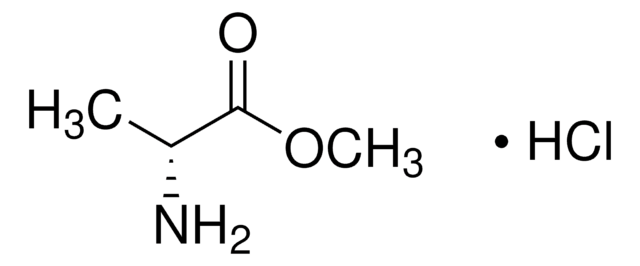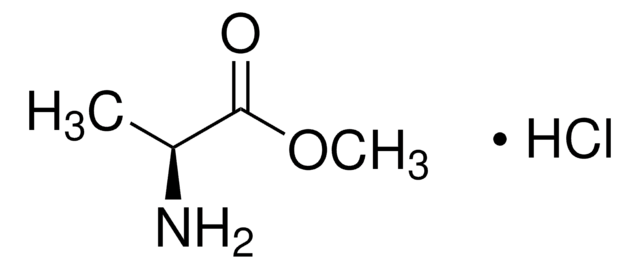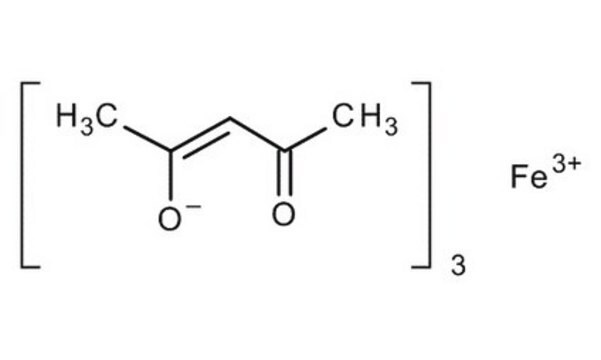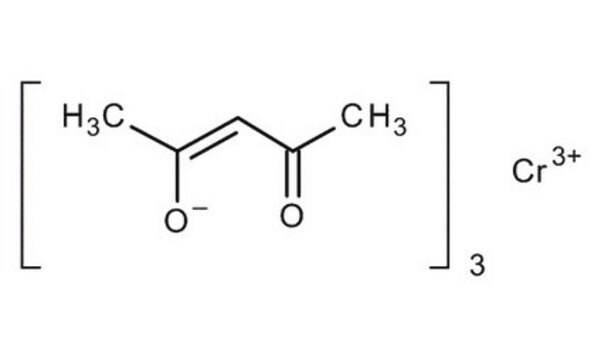推荐产品
品質等級
化驗
≥99.9% trace metals basis
形狀
powder
反應適用性
core: iron
reagent type: catalyst
mp
180-182 °C (dec.) (lit.)
密度
5.24 g/mL at 25 °C (lit.)
SMILES 字串
CC(=O)\C=C(\C)O[Fe](O\C(C)=C/C(C)=O)O\C(C)=C/C(C)=O
InChI
1S/3C5H8O2.Fe/c3*1-4(6)3-5(2)7;/h3*3,6H,1-2H3;/q;;;+3/p-3/b3*4-3-;
InChI 密鑰
AQBLLJNPHDIAPN-LNTINUHCSA-K
正在寻找类似产品? 访问 产品对比指南
一般說明
應用
- A iron precursor for the synthesis of Fe3O4/carbon composite fibers via forcespinning technique. This composite material used in the formation of high-performance anode materials for lithium-ion batteries.
- A precursor for the synthesis of iron-containing metal-organic frameworks (MOFs) for the applications in rechargeable alkali-ion batteries.
- An additive to enhance the efficiency of the N-hydroxyphthalimide (NHPI) catalyst in the oxidation of cumene.
- A solvent activation agent in the fabrication of polyamide membranes, which are used in reverse osmosis (RO) applications.
- As a MOCVD precursor for highly crystalline (Zn,Fe)Fe2O4 films and magnetic property measurements of these films. Iron (III) acetylacetonate may be used as a precursor for the synthesis of water-soluble magnetite nanoparticles, which may find applications in magnetic hyperthermia treatment.
- As a MOCVD precursor for highly crystalline (Zn,Fe)Fe2O4 films and magnetic property measurements of these films.
訊號詞
Danger
危險分類
Acute Tox. 4 Dermal - Acute Tox. 4 Inhalation - Acute Tox. 4 Oral - Eye Dam. 1
儲存類別代碼
11 - Combustible Solids
水污染物質分類(WGK)
WGK 3
閃點(°F)
Not applicable
閃點(°C)
Not applicable
個人防護裝備
dust mask type N95 (US), Eyeshields, Gloves
其他客户在看
商品
Professor Randal Lee (University of Houston, USA) discusses design considerations for iron oxide magnetic nanospheres and nanocubes used for biosensing, including synthetic procedures, size, and shape. The effects of these variables are discussed for various volumetric-based and surface-based detection schemes.
Professor Randal Lee (University of Houston, USA) discusses design considerations for iron oxide magnetic nanospheres and nanocubes used for biosensing, including synthetic procedures, size, and shape. The effects of these variables are discussed for various volumetric-based and surface-based detection schemes.
Magnetism and magnetic materials have been of scientific interest for over 1,000 years. More recently, fundamental investigations have focused on exploring the various types of magnetic materials and understanding the magnetic effects created by electric currents.
Thin film photovoltaic devices have become increasingly important in efficiently harnessing solar energy to meet consumer demand.
我们的科学家团队拥有各种研究领域经验,包括生命科学、材料科学、化学合成、色谱、分析及许多其他领域.
联系技术服务部门














